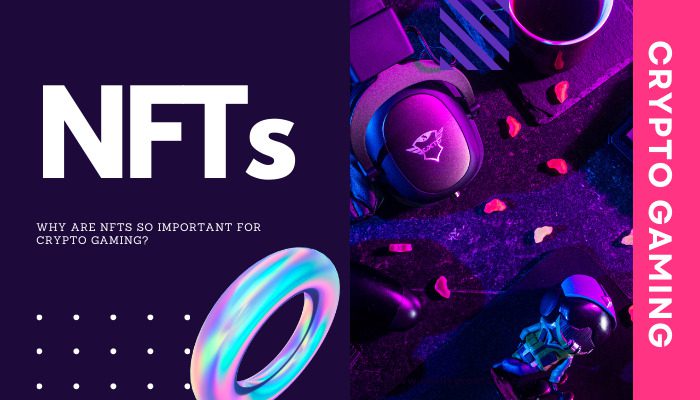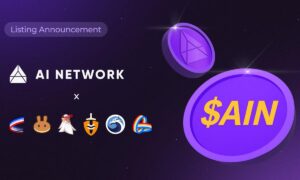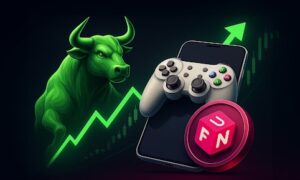Non-fungible tokens, or NFTs, became popular in early 2021. Before we get into the specifics of NFTs in the gaming business, let’s take a quick look at the industry’s current prospects.
The total NFT market was estimated to be worth $160 billion by 2020. Given the pandemic situation, which had a negative impact on most enterprises, this is a remarkable accomplishment. According to recent estimates, the gaming business will grow to $268 billion by 2025.
The Importance of NFTs in the Gaming Industry
We need to know how NFTs function before we can understand their importance in modern games. NFTs are non-replicable, cryptographic data pieces stored on the blockchain, that signify ownership of an attached asset. NFTs can be owned, bought, sold, and exchanged in the same way that any other tangible asset can.
Despite the fact that they are blockchain-based assets, NFTs are not the same as traditional cryptocurrencies. The most significant distinction is that each NFT is distinct and cannot be substituted for another.
Tweets, drawings, music files, and other types of data can all be stored as NFTs. They will be worth the same as the original files, and they will be available for purchase together with confirmation of ownership.
NFTs might usher in a new era of work and employment, with people earning real money for in-game achievements or renting out their NFT characters to P2E gaming scholars for a share of the profits.
Play-to-earn games are one way for NFT games to gain popularity. The majority of these games are free to download, but players need to purchase NFTs before they can begin playing. Players earn tokens instead of trophies or badges while they play. These tokens can be used to buy more in-game NFTs or can be sold or traded for other tokens.
Axie Infinity, a game in which players gather, raise, breed, combat, and trade Axies, is one of the fastest-growing NFT games. Its player population exploded around the time of the epidemic in 2020-2021, when many lost their jobs and discovered that Axie provided a pandemic-friendly source of money.
Some participants put their own money into the game, while others lend creatures to those who can’t afford to do so in exchange for a percentage of the earnings. Many Axie Infinity players make around $500 per month.
As of early September, Axie had sales of $2.05 billion, with over 1 million daily active users and a daily trading volume of over $650 million. Axie’s native token, AXS, has risen 10,000 percent in 90 days, accounting for $2.08 billion of the $2.3 billion in total NFT gaming trade volume in Q3 2021.
Affyn is another P2E gaming company that is working on NFT games. They received $20 million in investment across various stages, to build out their NFT and metaverse gaming project called Nexus.
Users will be able to explore, play, and participate in activities depending on their geolocation in a Metaverse named “Nexus” which will be constructed on a digital layer linked to the actual world.
Players in the Nexus Metaverse will be able to catch and train “Buddies,” which are a collection of NFTs that may be used in missions, PvP fights, and raids.
Plutonians, a Solana-based, virtual reality space game is also working on bringing NFTs to the gaming space. Their IGO sold out within a minute to build out its P2E gaming ecosystem.
Plutonians is developed on the WebXR and Unreal 5 engines, which means that in addition to regular web and mobile platforms, players will be able to experience the game in augmented reality (AR) and virtual reality (VR).
Players may personalize their gaming experience using a planet, plot, and content editor, as well as an in-game NFT marketplace where they can buy, sell, or trade spacecraft components of various rarity.
NFT gaming has yet to break through to the mainstream, although there is widespread belief that it will.
Derek Lau, Game Director for Guild of Guardians, spoke on this phenomenon saying, “NFT gaming has run headlong into an adoption barrier, and the industry hasn’t yet witnessed a truly “killer app” to convert the larger gaming community or industry leaders.”
Even NFT fans, however, believe that there are still flaws with NFT gaming. The gameplay at times is frequently subpar, with money-making forming the game’s goal rather than complementing it. Some say there’s a danger of developing a pay-to-win ecosystem rather than a play-to-earn one. It takes away the fun of gaming if those with significant money can buy their way to success.
Developers must also enhance how NFTs are integrated into the game’s flow, and difficult questions such as what cut the platform takes and how and where the buying and selling occurs must still be answered.
Several blockchain networks, including Binance Smart Chain (BSC), Polygon, Hive, Harmony, Solana, and Flow, are acquiring players, indicating that the NFT gaming infrastructure is developing.
Hawku, an NFT firm, recently raised $4 million for its platform, which will supply data to enable more accurate NFT valuation, while Sandbox, an NFT gaming platform, recently raised $93 million in a funding round in October 2021.
NFTs may be utilized in a variety of ways in the gaming industry to facilitate the ownership and transfer of digital assets. As a result of companies like Riot Games and Epic Games disrupting the business by releasing games for free, first-person shooter and online battle-arena games have surged in popularity rapidly.
Along with those free games, “skins” — cosmetic upgrades, costumes, and weaponry that can be used to customise gaming avatars — have grown in popularity, and gamers frequently pay a premium for these sorts of changes. Roblox’s platform allows users to create and decorate their identities in-game, which is one of the reasons for the company’s success.
Skins and other accessories could be transferred across games with the use of NFTs. What if a StatTrak M4A4 Howl assault weapon from Counter-Strike: Global Offensive (worth $8,000 in real world currency rare drop rate) could be brought into Call of Duty: Modern Warfare?
NFTs can also be used for various types of games. Take Warcraft or Minecraft, for example: both games allow players to construct their own gaming worlds or maps, and both give a wealth of tools to let players unleash their imagination and create sophisticated, one-of-a-kind worlds.
But what if gamers could sell their exclusive map or universe — as well as their authorship or rights to it? NFTs may be able to assist in this endeavor.
UniX Gaming is one platform that is currently working on making it easier for players to use NFTs in P2E gaming.
The gaming guild and community aims to be the industry’s leading project in the NFT gaming sector in the long run, fostering widespread adoption. Unix Gaming follows a similar operational paradigm to other gaming guilds.
The majority of the guild’s revenue comes from investing in, buying, and manufacturing valuable NFT assets in blockchain games. UniX focuses on process automation, which simplifies processes like renting and staking NFTs.
One of the most notable features is NFT Renting, which connects users who wish to make money by playing games with investors.
The functionality allows NFT to rent and lease with a profit share of 50/50. UniX will handle all accounts and provide free training to gamers, allowing them to earn 30% more money than normal players.
Through scholar training programmes, the site hopes to strengthen gaming teams (such as Axie teams). UniX might make it simpler for P2E students to make a living by focusing on developing a robust P2E community.
Conclusion
While speculation and market volatility persist, the use case and practicalities of NFTs are likely to endure. A foundational technology that can give a reliable and verifiable source of creatorship for digital art is urgently needed.
Ethereum, a decentralised blockchain network, is a perfect platform for providing a ledger that, in essence, connects a smart contract to works of digital art.

































